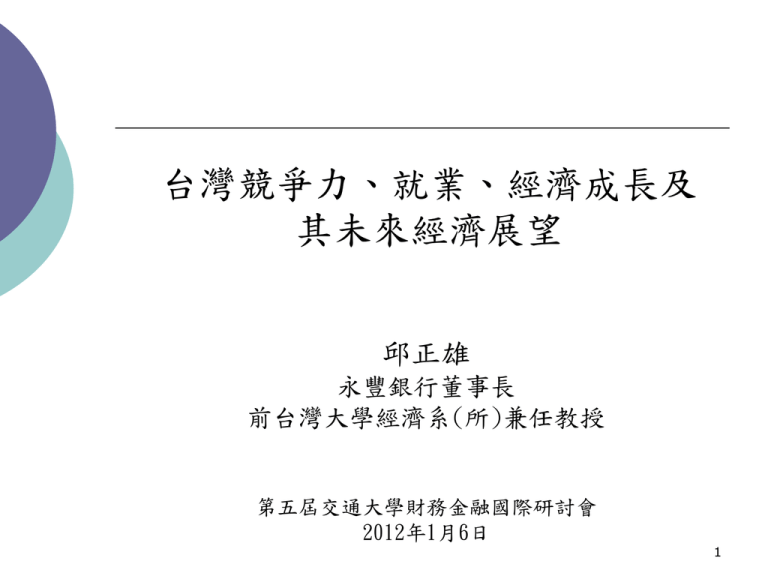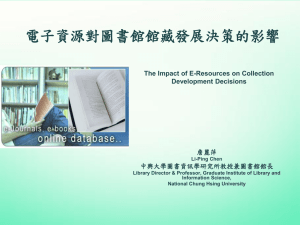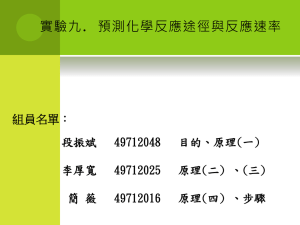Taiwan's Competitiveness, Employment, Economic Growth and Its Future Economic Prospects( )
advertisement

台灣競爭力、就業、經濟成長及 其未來經濟展望 邱正雄 永豐銀行董事長 前台灣大學經濟系(所)兼任教授 第五屆交通大學財務金融國際研討會 2012年1月6日 1 大綱 一. 簡介:全球化下美國、台灣、韓國生產 力、就業及經濟發展的問題 1. 2. 3. 供應鏈、貿易與就業 生產力 金融創新 二. 台灣就業與經濟的發展:全球化下台灣 的技術、貿易、生產力、金融 1. 2. 3. 台灣的就業及失業率 台灣的生產(貿易)供應鏈及生產力 台灣金融創新與經濟發展 2 大綱 三. 結語:2010年後台灣經濟發展策略: 由不平衡性(unbalanced)發展轉向更 具平衡性(balanced) 、包容性的發展 1. 2. 3. 4. 財稅改革:營利事業所得稅之改革 服務業及中小企業的發展:十大重點服務業; 產業發展:六大新興產業及四大智慧型產業 發展 兩岸智慧財產權保護協議、ECFA、自由貿易 協定 黃金十年 3 一.簡介:全球化下美國、台灣、 韓國生產力、就業及經濟發展 的問題 4 經濟大蕭條(Great Recession)後全球對就業、 失業與國際競爭力的重視 1.諾貝爾經濟學獎得主Michael Spence, Foreign Affairs (July/Aug 2011, Nov/Dec 2011) 2.World Economic Outlook, International Monetary Fund (Sept. 2011) 3.美國與台灣金融競爭力比較,St. Louis Fed(2010), Central Banking (2011) 4.經濟日報邀請2010年DMP諾貝爾得主來台演講 (2011) 5 經濟大緊縮前20年(1980年2007年)技術及貿易對先進國 家就業的影響 M. Spence(2001):技術進步 (1)1980年代,自動化設備使 機器替代標準化生產的勞工就 業,但對先進國家全球化仍有 良性作用。 (2)1990年代,ICT技術進步後, 全球生產供應鏈造成生產重分 配,對先進國家而言,海外代 工大幅替代國內生產就業,造 成先進國家製造業比重下降, 服務業比重上升,但也造成中 國大陸及印度經濟之大幅成長。 6 資料來源:World Economic Outlook, IMF, September 2011 資料來源: Bloomberg Businessweek, October 24 — October 30, 2011 7 資料來源:H. Noda and K.. Kyo, “Bayesian Estimation of the CES Production Function with Labor- and Capital-Augmenting Technical Chaing, Research Group of Economics and Management, No. 2011-E01, 2011.6 8 資料來源:H. Noda and K.. Kyo, “Bayesian Estimation of the CES Production Function with Labor- and Capital-Augmenting Technical Change”, Research Group of Economics and Management, No. 2011-E01, 2011.6 9 A St Louis Federal Reserve paper published in August looks at the importance of financial development on economic development and finds technological innovation plays a large role in country growth. Jeremy Greenwood, Juan Sánchez and Cheng Wang, the authors of the paper, use a costly state verification model of financial intermediation to measure intermediation spreads and the firm-size distribution from 1974 to 2004. The authors then compare results using cross-country interest-rate spreads from international data on per-capita GDP. The analysis suggests that financial intermediation is important for economic development. Greenwood, Sánchez and Cheng show that about 30% of US growth can be attributed to technological improvement in financial intermediation, while roughly half of Taiwan's growth can be attributed to financial innovation. The authors conclude that world output could increase somewhere between 65% and 88% if all countries adopted the best financial practice, as this leads to funds being directed away from inefficient firms and towards more productive ones. 資料來源:http://www.centralbanking.com/central-banking/research/1727212/st-louis-fed-financial-innovation-growth 10 二.台灣就業與經濟的發展:全球 化下台灣的技術、貿易、生產力、 金融 11 台灣就業人口 萬人 120 就業人口 總計 製造業 服務業 100 80 60 40 20 0 '90 '91 '92 '93 '94 '95 '96 '97 '98 '99 '00 '01 '02 '03 '04 '05 '06 '07 '08 '09 '10 '11 *資料來源:主計處 12 國際資訊電子業產品產銷量及價格波動大,台灣生產 廠商甚須依賴資本市場籌資支應 DRAM bit growth rate and ASP trend 100% 80% 60% 40% 2005~2010 supply CAGR 53% 20% 60% 0% 40% -20% -40% 20% 2005~2010 ASP CAGR -29% -60% Bit supply YoY(LHS) 2012(F) 2011(F) 2010 2009 2008 2007 2006 2005 -80% 2004 0% ASP YoY(RHS) 資料來源:Gartner,永豐金控研究總處整理,Sep. 2011 13 資料來源:Iana Dreyer, Fredrik Erixon, Hosuk Lee-Makiyama and Razeen Sally, BEYOND GEOPOLITICS – THE CASE FOR A FREE TRADE ACCORD BETWEEN EUROPE AND TAIWAN, ECIPE Occasional Paper, No. 3/2010 14 台灣失業率(1990~2011e) % 失業率 5.85 6 5.17 5.21 4.99 5 4.57 4.44 4.13 3.91 3.91 4 4.14 4.38 2.92 3 2.60 2 2.72 2.69 2.99 1.79 1.67 1.51 1.51 1.56 1.45 1 '90 '91 '92 '93 '94 '95 '96 '97 '98 '99 '00 '01 '02 '03 '04 '05 '06 '07 '08 '09 '10 '11 *資料來源:主計處;2011年數據為永豐金控研究總處預估值 15 台灣Beveridge Curve Beveridge 曲線(1997~2011) 3.5 1998 3.3 1997 2011 2000 1999 2001 V:空缺率 (%) 3.1 2.9 U=V 2.7 2006 2007 2.5 2005 2004 2002 2003 2010 2.3 2.1 2009 2008 1.9 1.7 1.5 2.5 3.0 3.5 4.0 4.5 5.0 5.5 6.0 U:失業率(%) *資料來源:主計處;年平均值,2011年空缺率 為2月資料,失業率為全年預測值。2011年10月 失業率為4.3%。 16 經濟(產出)成長率會計式 17 % p.19生產函數 (2)或(3)式 15 工業及服務業 製造業 服務業部門 10 4.95 5 p.19生產函 數(1)式 1.62 0 -5 0.20 1966 1969 1972 1975 1978 1981 1984 1987 1990 1993 1996 1999 2002 2005 2008 Figure 1:台灣每人資本淨額密集度變動率(5年移動平均) 2: 註:每人資本淨額密集=資本淨額/就業人數 2001年後係依第8次修訂之中華民國行業標準分類,及93SNA國民所得統計資料編算,部分行業分類與2001年 前不一致。 資料來源:圖1-行政院主計處,作者邱正雄整理,蔡玉時繪圖。圖2、圖3-Hideo Noda & Koki Kyo:Bayesian Analysis of Economic Growth in Taiwan and Mainland China via Dynamic Production Functions, Research Group of Economics and Management No. 2008-E04, 2008/10 18 p.19生產函數(1)式 資料來源:H. Noda and K.. Kyo, “Bayesian Estimation of Economic Growth in Taiwan and Mainland China via Dynamic Production Functions”, Research Group of Economics and Management, No. 2008-E04, 2008.10 19 Taiwan TFP & Export YoY % 工業及服務業 服務業 製造業 出口(RHS) % 8 40 6 30 20 4 10 2 0 0 -10 -2 -20 -4 -30 1982 1985 1988 1991 1994 1997 2000 2003 2006 2009 *資料來源:主計處,由於資料不連續,重新以2001=100,計算YoY *總要素生產力:每單位投入所新增加的產量(投入包含勞動、資本、能源、原材料及企 業服務五項) *Total Factor Productivity: Output per combined unit of capital, labor, energy, non-energy materials, and business service input. 20 台灣勞動生產力指數(Indexes of Labor Productivity) 16 勞動生產力指數年增率 % 全體 製造業 服務業 14 12 10 8 6 4 2.96 2.23 2 1.74 0 -2 1990 1993 1996 1999 2002 *資料來源:主計處;2011年資料為前三季指數平均後得出 2005 2008 2011* 21 資料來源:J. Greenwood, J.M. Sanchez and C. Wang, “Quantifying the Impact of Financial Development on Economic Development”, Working Paper 2010-023B, Federal Reserve Bank of St. Louis. 22 資料來源:J. Greenwood, J.M. Sanchez and C. Wang, “Quantifying the Impact of Financial Development on Economic Development”, Working Paper 2010-023B, Federal Reserve Bank of St. Louis. 23 製造業債務占淨值比 單位:% Taiwan 上市 上櫃 Country Korea US Japan 1996 307 198 176 72 76 2000 210 187 166 72 77 2005 132 152 129 69 81 2006 137 148 127 65 69 2007 136 148 125 61 77 2008 174 162 138 67 90 2009 151 145 136 66 85 美IT產業為131% 資料來源: Bloomberg;台灣部份,資料取自CMoney 24 三.結語:2010年後台灣經濟發展 策略:由不平衡性(unbalanced) 發展轉向更具平衡性 (balanced) 、包容性的發展 25 Taiwan Economic Growth Trend 101 1994~2000平均 成長率為4.85% Precrisis trend(Pre 2001) Precrisis trend(Pre 2008) Actual trend 99 2001~2007平均 成長率為3.78% 97 1997~2011實際值 95 93 1997 1999 2001 2003 2005 2007 2009 2011 2013 2015 *資料來源:IMF, Precrisis trend(Pre 2001)為以1994~2000年成長平均計算; Precrisis trend(Pre 2008)為以 2001~2007年成長平均計算。 *所有數值皆以原始值取Log後畫圖。 26 2010年起我國營利事業所得稅率,非「促產」產業在改 革前營所稅稅率為25%,在改革後營所稅稅率為17% 資本淨額密集度變動率(5年移動平均) % 15 10 4.95 5 1.62 0 0.20 -5 1966 1969 1972 1975 1978 1981 1984 1987 1990 1993 1996 1999 2002 2005 2008 工業及服務業 製造業 服務業部門 註:2001年後係依第8次修訂之中華民國行業標準分類,及93SNA國民所得統計資料編算,部分行 業分類與2001年前不一致。 資料來源:行政院主計處 27 資料來源:A. Kling and N. Schulz, From Poverty to Prosperity, 2009 28 資料來源:20111201經濟日報 29 •長期而言,國際經濟情況穩定為維持就業 最佳方法,此外一般研究者均強調,先進國 家為避免中間所得階層就業的下降,須加強 再進修,提升教育,擴大非製造業部門的生 產力。可供我國參考。 •台灣營利事業所得稅率由25%下降為17% , 對傳統製造業、服務業(以中小企業為主) 的 所得及生產力將會有效提高。 •12年國教及加強中小企業融資功能。 30 促進產業和諧發展:「中小企業融資/GDP」 48 % 12 10 40 8 32 6 4 24 2 16 0 中小企業融資/GDP(LHS) GDP成長率(RHS) 人均GDP成長率(RHS) 8 -2 -4 0 1991 中小企業融資/GDP (%) GDP成長率 (%) 人均GDP成長率 (%) 中小企業融資/GDP (%) GDP成長率 (%) 人均GDP成長率 (%) 1994 1991 28.9 7.9 10.7 2001 33.4 -1.7 -3.2 Source: 台灣央行,主計處,TEJ 2000 1997 1992 43.2 7.6 10.5 2002 27.1 5.3 4.3 1993 44.0 6.7 9.4 2003 26.3 3.7 2.3 1994 45.4 7.6 8.4 2004 24.4 6.2 5.9 2006 2003 1995 43.9 6.4 7.9 2005 21.8 4.7 2.9 1996 40.5 5.5 7.8 2006 23.1 5.4 3.9 1997 40.3 5.5 7.5 2007 24.0 6.0 5.0 2009 1998 37.5 3.5 6.4 2008 25.1 0.7 -2.6 1999 35.7 6.0 4.0 2009 25.9 -1.9 -1.5 2000 33.9 5.8 4.8 2010 27.2 10.9 8.7 31 依據世界銀行資料: 2009年全球SME放款總額10兆美元;高所得經 濟體佔70%的SME授信額;就「SME放款/GDP」 比率而言,高所得經濟體之中位數為13%,發 展中經濟體之比率為3%。 資料來源: Ardic, Mylenko, Saltane, 《Small and Medium Enterprises:A Cross-Country Analysis with a New Data Set》, World Bank, Jan 2011, p. 13. 32 兩岸和平發展:兩岸直航、兩岸智慧財產 權保護協議、ECFA、金融MOU、搭橋計 劃、投資保護協議 區域及全球化:加入ASEAN+3,FTA(自由 貿易協定) 33




